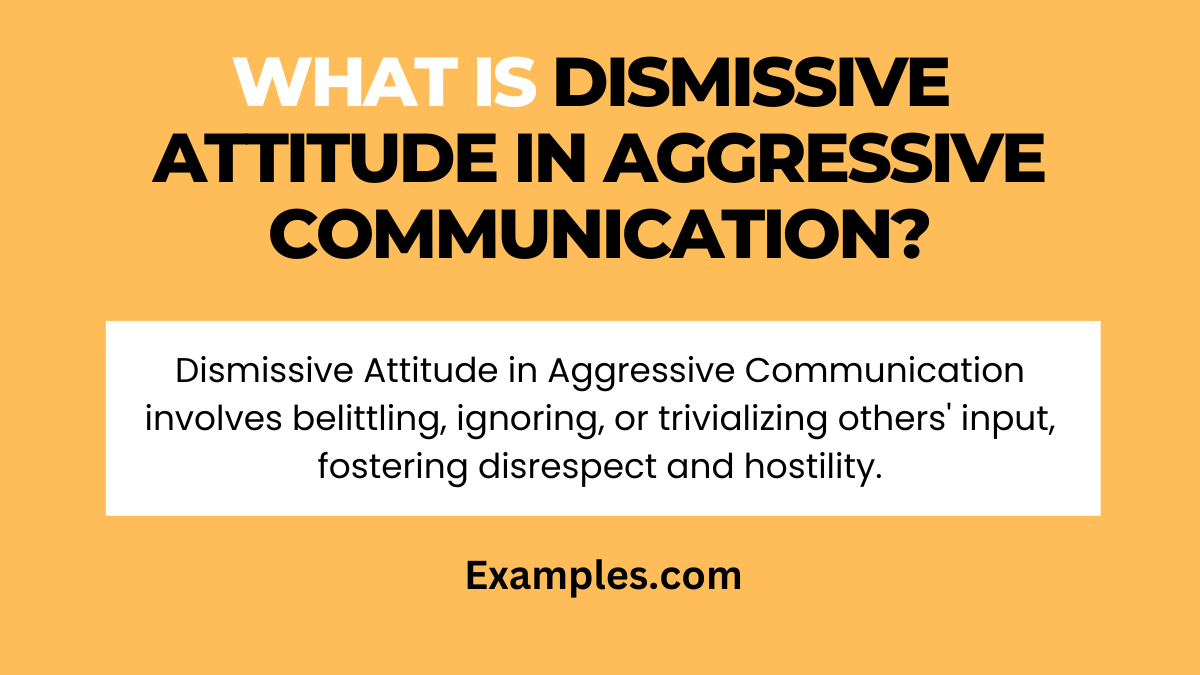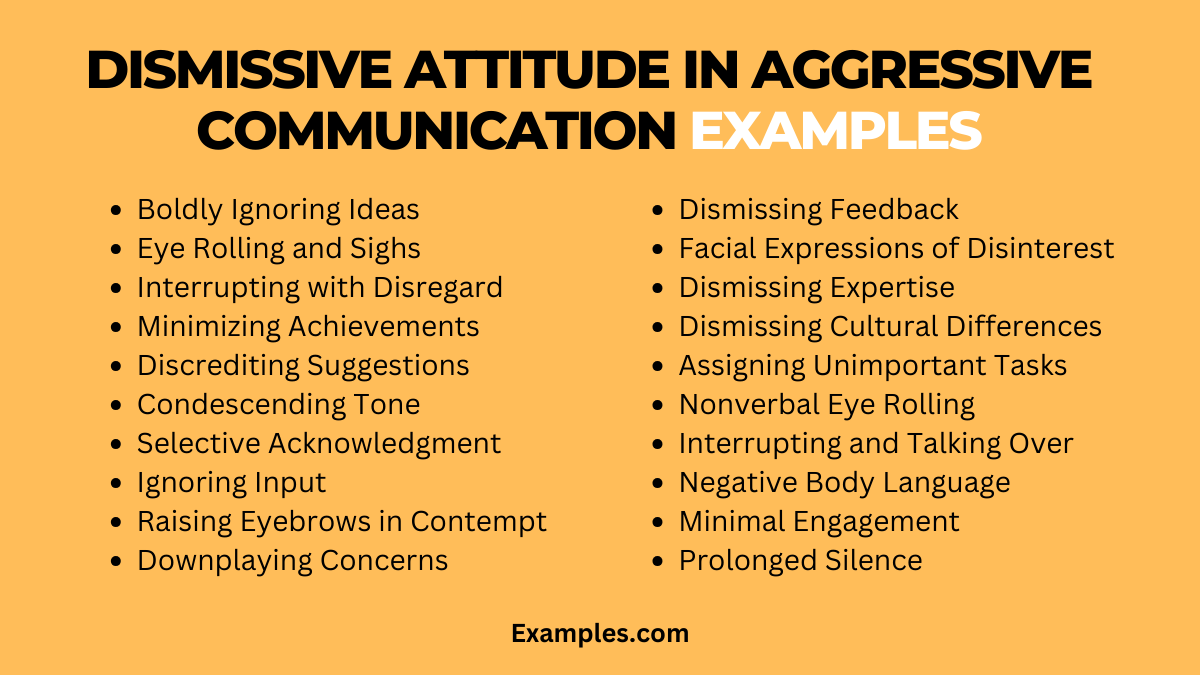19+ Dismissive Attitude in Aggressive Communication Examples
Discover the intricacies of a Dismissive Attitude in Aggressive Communication through our comprehensive guide. Uncover real-life Communication Examples illustrating how this behavior manifests and learn valuable tips to navigate assertively. This guide is your key to understanding the impact of dismissive behavior on effective communication dynamics. Elevate your Communication Skills and cultivate strategies to foster more meaningful interactions in both personal and professional spheres. Dive into our Complete Guide for actionable insights.
What is Dismissive Attitude in Aggressive Communication?

A Dismissive Attitude in Aggressive Communication refers to a behavior where an individual belittles, ignores, or trivializes others’ input or opinions, often undermining their value. This dismissiveness can manifest through nonverbal cues, verbal remarks, or a general lack of acknowledgment. It reflects a disregard for the perspectives of others and can contribute to a toxic communication environment.
What is the Best Example of Dismissive Attitude in Aggressive Communication?

In a team meeting, when a colleague enthusiastically presents a well-thought-out idea, a manager responds with a dismissive wave, saying, “We’ve tried that before; it won’t work.” The manager’s body language, tone, and refusal to engage convey a dismissive attitude, undermining the team member’s contribution and discouraging further input. This example illustrates how a dismissive approach can hinder collaboration and stifle innovation within a communication context.
20 Dismissive Attitude in Aggressive Communication Examples

Dismissive attitudes in aggressive communication often manifest through non-verbal cues, undermining others’ contributions. Recognizing these instances is crucial for fostering a positive communication environment.
- Boldly Ignoring Ideas: When a team member suggests improvements, a dismissive individual might visibly ignore or overlook their input, belittling their ideas.
- Eye Rolling and Sighs: Displaying frustration through eye rolls and audible sighs conveys dismissiveness, signaling disinterest in the ongoing conversation.
- Interrupting with Disregard: Cutting off others mid-sentence without acknowledging their thoughts demonstrates a dismissive attitude, disrupting the flow of communication.
- Minimizing Achievements: Responding to accomplishments with phrases like “It’s not a big deal” downplays achievements, conveying a dismissive stance.
- Discrediting Suggestions: Dismissing innovative suggestions with statements like “That won’t work” discourages creative input, stifling collaboration.
- Condescending Tone: Using a condescending tone when responding to ideas or questions undermines the speaker’s confidence, fostering a dismissive atmosphere.
- Selective Acknowledgment: Acknowledging only certain individuals while ignoring others showcases favoritism, contributing to a dismissive workplace dynamic.
- Ignoring Input: Purposefully ignoring emails, messages, or input in meetings sends a clear signal of indifference, perpetuating a dismissive communication style.
- Raising Eyebrows in Contempt: Physically expressing contempt through raised eyebrows or smirks conveys disdain, eroding trust in communication.
- Downplaying Concerns: Minimizing others’ concerns by saying “You’re overreacting” dismisses their emotions, hindering open dialogue.
- Dismissing Feedback: Responding to constructive feedback with dismissive remarks hinders personal and professional growth, creating a hostile communication climate.
- Facial Expressions of Disinterest: Expressions like blank stares or checking the time convey disinterest, undermining the importance of the ongoing conversation.
- Dismissing Expertise: Invalidating someone’s expertise or experience suggests a dismissive attitude, discouraging valuable contributions.
- Dismissing Cultural Differences: Ignoring or downplaying cultural nuances demonstrates insensitivity, contributing to a dismissive communication environment.
- Assigning Unimportant Tasks: Delegating menial tasks in response to serious contributions implies insignificance, perpetuating a dismissive tone within the group.
- Nonverbal Eye Rolling: Rolling one’s eyes dismissively during discussions signals disrespect and creates a negative atmosphere within the communication setting.
- Interrupting and Talking Over: Habitually interrupting others or talking over them communicates a lack of regard for their viewpoints, fostering a dismissive interaction style.
- Negative Body Language: Exhibiting closed-off body language, such as crossed arms or turning away, adds to the dismissive nonverbal cues, hindering effective communication.
- Minimal Engagement: Offering minimal responses, such as monosyllabic answers or grunts, reflects disengagement and reinforces a dismissive demeanor.
- Prolonged Silence: Deliberate, prolonged silences in response to communication attempts convey disinterest and contribute to a dismissive environment.
Dismissive Attitude in Aggressive Communication Examples in Workplace
A dismissive attitude in the workplace can hinder collaboration and erode morale. Individuals may exhibit this behavior through:
- Ignoring Suggestions: Dismissing valuable input with silence, showing a lack of consideration for coworkers’ ideas.
- Eye Rolling in Meetings: Rolling eyes when colleagues speak signals disrespect and undermines the collaborative spirit.
- Interrupting Frequently: Repeatedly interrupting others during discussions demonstrates a dismissive approach, hindering effective communication.
- Refusing to Acknowledge Achievements: Failing to recognize or belittling coworkers’ accomplishments reflects a dismissive attitude.
- Providing Minimal Feedback: Offering vague or minimal feedback during evaluations conveys indifference to colleagues’ professional growth.
Dismissive Attitude in Aggressive Communication Examples for Employees
Employees may face dismissive attitudes from superiors or coworkers. Common examples include:
- Supervisor Ignoring Ideas: A dismissive boss may overlook innovative suggestions without acknowledgment or feedback.
- Colleague Dismissing Contributions: A coworker might belittle others’ efforts, diminishing their contributions in team settings.
- Eye Rolling in Meetings: Displaying dismissive nonverbal cues, like eye rolling, can create a hostile work environment.
- Ignoring Professional Input: Refusing to consider valuable input from colleagues demonstrates a dismissive and counterproductive approach.
- Minimal Recognition for Hard Work: Receiving little to no acknowledgment for dedicated work effort can lead to employee dissatisfaction.
How does a Dismissive Attitude Contribute to Aggressive Communication Dynamics?
A dismissive attitude significantly influences the dynamics of aggressive communication. By trivializing others’ opinions, achievements, or ideas, individuals create an environment of hostility and disregard. Understanding its contribution is crucial for navigating aggressive communication effectively.
- Undermining Collaborative Efforts: A dismissive attitude undermines collaboration by belittling or ignoring the input of others, fostering an atmosphere of hostility and diminishing teamwork.
- Fueling Resentment and Frustration: Continuous dismissal breeds resentment and frustration among individuals, contributing to an aggressive communication dynamic filled with negativity and strained relationships.
- Heightening Defensive Responses: A dismissive demeanor prompts defensive reactions as individuals feel compelled to protect their ideas or contributions from being devalued, escalating aggressive communication tendencies.
- Creating a Hostile Work Environment: When a dismissive attitude is prevalent, it contributes to a hostile work environment, hindering effective communication, collaboration, and overall workplace satisfaction.
- Eroding Trust and Cooperation: Consistent dismissal erodes trust and cooperation, as individuals become reluctant to engage openly, fearing their contributions will be dismissed or undermined.
In What Ways can Individuals Address a Dismissive Attitude in Aggressive Communication?
Navigating a dismissive attitude in aggressive communication requires strategic approaches. Consider the following steps:
- Cultivate Open Dialogue: Encourage open communication where individuals feel empowered to express concerns and opinions without fear of dismissal.
- Provide Constructive Feedback: Offer constructive feedback to address dismissive behavior, focusing on its impact and suggesting alternative, more inclusive communication approaches.
- Establish Clear Expectations: Set clear expectations for respectful communication within the team, emphasizing the importance of acknowledging and valuing diverse perspectives.
- Promote Active Listening: Encourage active listening to foster understanding and collaboration, discouraging dismissive behaviors that hinder effective communication.
- Conduct Sensitivity Training: Implement sensitivity training programs to raise awareness about dismissive attitudes, fostering a culture of respect and consideration.
What Role Does a Dismissive Attitude Play in Shaping Aggressive Communication Styles?
Understanding the role of a dismissive attitude is crucial for comprehending aggressive communication styles:
- Undermining Others: A dismissive attitude contributes to aggressive styles by undermining the contributions, ideas, and achievements of others, establishing a superiority dynamic.
- Creating Power Imbalance: It plays a role in shaping aggressive communication by creating a power imbalance, where individuals with dismissive attitudes exert control over those they belittle.
- Fueling Retaliatory Behaviors: A dismissive attitude fuels retaliatory behaviors as individuals respond defensively, escalating conflicts within communication dynamics.
- Perpetuating Negative Tone: It perpetuates a negative tone within communication, leading to a toxic environment where dismissive remarks become a norm in interactions.
- Hampering Collaboration: The dismissive demeanor hampers collaboration by discouraging open dialogue, hindering the development of constructive and cooperative communication styles.
In conclusion, addressing a dismissive attitude in aggressive communication is pivotal for fostering a positive and collaborative environment. By recognizing its detrimental impact and implementing proactive strategies, individuals can contribute to a healthier communication dynamic. Emphasizing open dialogue, constructive feedback, and a commitment to respect transforms dismissive interactions into opportunities for growth and understanding, ultimately shaping a more harmonious workplace.



